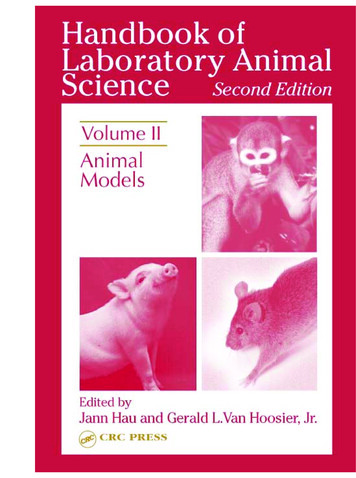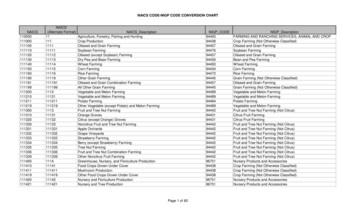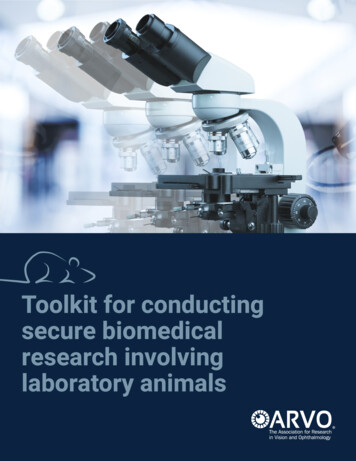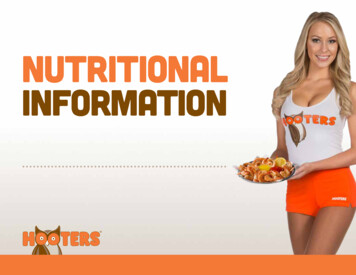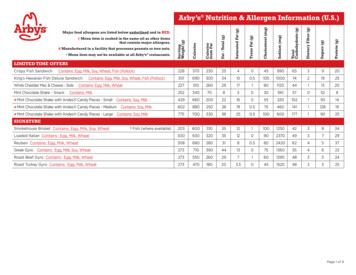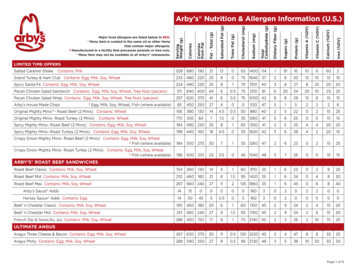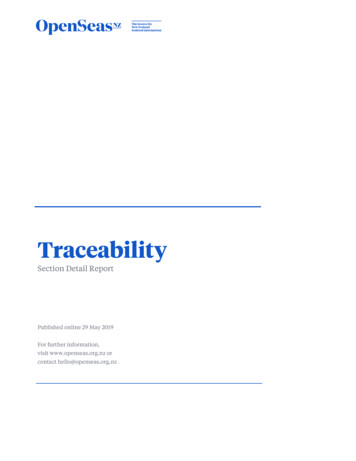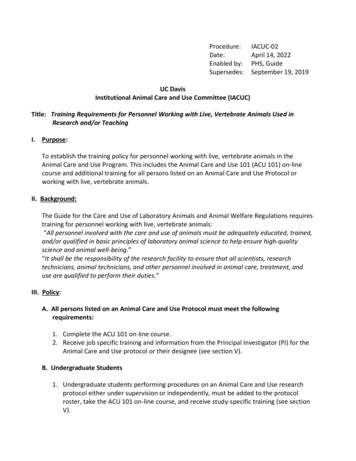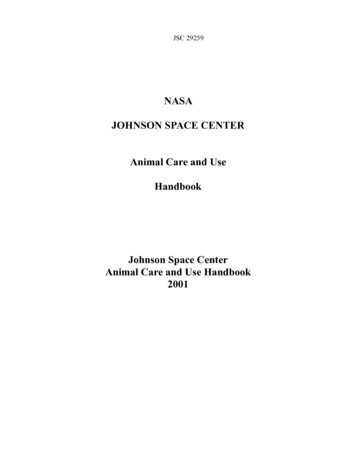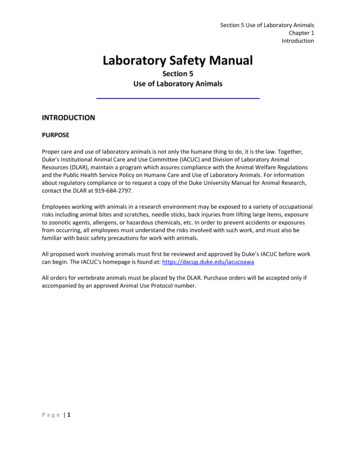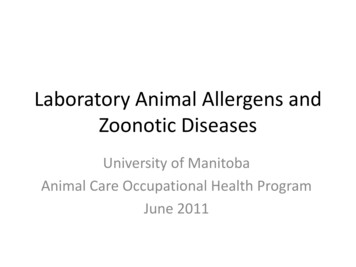
Transcription
Laboratory Animal Allergens andZoonotic DiseasesUniversity of ManitobaAnimal Care Occupational Health ProgramJune 2011
ObjectivesAt the end of this training you should– Recognize the potential negative impact animalallergensdef1 and zoonotic diseases can have on the healthof a worker and their ability to work in the animal carefield.– Develop a working knowledge of the Universal Precautionsfor Lab Animal Work (UPLAW) and how it pertains to yourwork with lab animals.– Successfully complete a short written test to demonstrateyour working knowledge of the UPLAW (attached).– Effectively apply the protection principals of the UPLAWduring your work with lab animals.
Allergy Basics Immune response to antigens which may beexcessive, and cause harm or inconvenience tothe host Response is to harmless antigens that wouldnot pose a danger to the host if not for theallergic reaction Requires previous exposure for outwardsymptoms to occur
Allergic Reactions to Lab AnimalAllergens Skin reactionsdef2 Hay fever (allergicrhinitis)def3 Lower respiratorytract reactions(asthmadef4) Anaphylactic shock(severe wholebody reactiondef5) Symptoms can es.wordpress.com/2007/04/sneeze1.jpg
Animal Allergens Antigenic particulatesFurDanderUrine (Major UrinaryProtein)SalivaSerum proteinsTissuesExposure route Carried in bedding dust Cage dumping Animal handling
Zoonosis Diseases transmitted from animals to humans. Not common in purpose bred lab animals. Persons at higher risk suffer ptoms-before-buying-dog-prescriptionsonline/– defective immune systems– those who are under severe stress– have chronic illnesses Vaccines should be given to at risk workers where appropriate(rabies) Use of personal protective equipment discussed under in theUPLAW and effective hygiene should be effective in preventinghazardous exposure to most relevant zoonotic agents.
Zoonosis Special note: Toxoplasmosis gondii - Spread bythe oocysts shed in cat feces. Humantoxoplasmosis can result in spontaneousabortion, prematurity, stillbirth or congenitaldefects. Rabies is a risk from wild source mammals. Further information in Guide to the Care and Useof Experimental Animals Vol 1, 2nd Edn. AppendixVII gives a list zoonotic agents, their animal hostsand mode of transmission (appended)
Routes of Transmission or Exposure Injection (contaminated sharps)Inhalation (airborne contaminants)Ingestion (eat lunch with dirty hands)Skin contactMucous membranes (rub eyes with dirtyfingers)
Greatest Risk of Worker ExposureWorkers are at greatest risk for exposure toallergens, zoonotic agents and hazardousresearch compounds when: In animal holding rooms Directly handling animals Performing procedures on animals such asshaving, injection, urine collection and surgicalprocedures. Working with contaminated bedding, cagechanging, cage dumping, etc.
S-10 Safe Work Practices 003Universal Precautions for Lab AnimalWork (UPLAW)Aspects of UPLAW most relevant to workers on a day to day basis. Engineering controls– Used to contain allergens and other hazards Administrative controls (training)– Lab animal Allergen and Zoonosis training Personal protective equipment– Gloves, back fastening gown or lab coat as per facility policy and an N95 respirator. Hygiene– Hand washing Responsibility– Facilities at the U of M have statement of compliance that deal withimplementation and non compliance by staff and facility users– Supervisors are required to provide required personal protective equipment– Workers are required to follow the safe work procedure Refer to the UPLAW appended to this document.
Personal Protective EquipmentHands Gloves disposable – nitrile gloves offer puncture resistance andreduced risk of allergic reactions seen with latex Change oftenBreathing N95 dust and mist respirators are filters will prevent workers frominhaling airborne allergens by excluding 95% of airborne particulatesfrom the workers breathing zone. See illustration below.Body (cover or replace street clothes and prevent contamination) Greens (normally worn by husbandry staff) Lab coats or back fastening gowns according to facility policy Pants/clothing that covers the legsFeet Full shoes (no sandals, flip flops or crocs!)PPE is to prevent contamination from reaching your skin, mucousmembranes (eyes, mouth, lungs) or personal clothing andshould be used when there is a risk of exposure to labanimal allergens such as when entering rooms that houselab animals or performing procedures on lab animals.
Hygiene Wash your hands (soft soap best) When entering and before leaving the animal holdingroom Hand washing is the best contamination controlmethod Food/beverages notallowed in animalholding facilitiesoutside designatedareas: Includes gum, waterbottles and coffeecups
Definitions1. Antigen (s) – “Any substance that can induce an immune response in humans or otheranimals is called an immunogen or antigen, and it is said to be immunogenic or antigenic.Typical antigens are components of microbes consisting of protein, carbohydrate, nucleicacid, lipid or combinations thereof, but any natural or synthetic substance can serve as anantigen.” Sharon, J. Basic Immunology 1998 pp. 5.2. Skin reaction (allergy) – “Contact urticaria (“Hives”) is typically due to the application of anallergen (usually a protein or glycoprotein) directly onto the skin. A common example is thedevelopment of wheal and flare reactions that produce welts when a person’s skin and thetail of a mouse or rat come into contact.” Occupational Helath and Safety in the Care andUse of Research Animals, National Academy Press 1997 pp. 52.3. Hay fever (also called allergic rhinitis) – “ the interaction of allergen with mast-cell-boundcomplementary IgE antibodies occurs in the nasal submucosa and in the conjunctival tissuesgiving rise to sneezing, mucus secretion and itchy, teary eyes.” Sharon, J. Basic Immunology1998 pp. 186.4. Lower respiratory tract reactions (asthma) – “Allergens are inhaled and often componentsof pollen, fur of animals such as cats, or feces of dust mites. The interaction of allergen withmast-cell-bound complementary IgE antibodies occurs in the submucosa of the airways,resulting in increased mucus secretion, coughing and constriction of the airway that leads todifficulty in breathing and to wheezing (characteristic of asthma).” Sharon, J. BasicImmunology 1998 pp. 186.5. Anaphylactic reactions (severe whole body reaction) – “ are triggered by the interaction ofallergen with IgE antibodies on mast cells and basophils in many tissues and in the blood, .Increased vascular permeability often causes swelling of the lips, tongue and larynx, thusmaking swallowing and breathing difficult. The smooth muscle contraction n the lungsresults in constriction of the airways that furtherer impedes breathing, leading to anincrease in the ratio of carbon dioxide to oxygen in the blood. This can result in loss ofconsciousness from an inadequate supply of oxygen to the brain. The widespread dilationof the capillaries and larger blood vessels causes a fall in blood pressure; a drastic fall inblood pressure (shock) is often fatal. This condition is called anaphylactic shock.” Sharon, J.Basic Immunology 1998 pp. 186.
Schedule-10 Safe Work Practice Universal Precautions for Lab Animal WorkAnimal Care Occupational Health University of Manitoba EHSO, Central Animal CareServices, Psychology Animal Holding Facility, Biological Sciences Animal HoldingFacility, Richardson Centre For Functional Foods and Neutraceuticals Animal HoldingFacilityDate January 8, 2010Universal Precautions for Lab Animal WorkPurpose:To describe the safe work procedures required for the use of lab animals inUniversity of Manitoba Animal Holding Facilities as pertains to labanimal allergens and agents of low or negligable hazard. These agentsmay or may not be controlled by the Workplace Hazardous MaterialsInformation System. These precautionary measures are also identified inorder to meet program requirements of the Canadian Council for AnimalCare with regards to lab animal allergens.Precautionary Statements:"Allergic reactions to animals are among the most commonconditions that adversely affect the health of workers involved in the careand use of animals in research The estimated prevalence of allergicsymptoms in the general population of regularly exposed animal careworkers ranges from 10% to 44% An estimated 10% of laboratoryworkers eventually develop occupationa related asthma." (NationalResearch Council). Workers with pre-existing allergies of any kind are athighest risk of developing lab animal allergies. Symptoms of laboratoryanimal allergies and sensitization to animal proteins may include contacturticaria, allergic conjunctivitis, allergic rhinitis, asthma, and anaphylaxis(see table 4.2 appended). Workers who experience lab animal allergysymptoms consistent with anaphylaxis should be reassigned to work thatwill eliminate their exposure to laboratory animal allergens.Tasks related to lab animal exposure include but are not limited to cagecleaning, animal handling, shaving, injection, blood and urine collection,surgery and euthanasia.Sources of lab animal allergens may include saliva, urine, dander, fur,Policy:The threshold limit value for lab animal allergens has not been establishedhowever prevalence of sensitization among regularly exposed animal careworkers is between 10% and 44%. This safe work procedure is to ensurethat worker exposure to lab animal allergens is limited to the lowest
amount reasonably achievable while work is conducted in all TheUniversity of Manitoba labs and facilities. This procedure is alsoapplicable for work with chemical and biological agents which areconsidered to be low or negligably hazardous.Responsibility:Principal Investigators (supervisors) who work with lab animals ordirect workers in their work with lab animals shall ensure that therequirements of this safe work procedure are met. This includesensuring access to engineering controls, establishment ofadministrative procedures including training and the provision ofall required personal protective equipment. Principal Investigators(supervisors) are also required to dispose of all hazardous waste inaccordance with University of Manitoba EnvironmentalManagement and the relevant Animal Holding Facility Procedures.All workers operating under the supervision of a PrincipalInvestigator or their designate (supervisor) shall adhere to theprovisions of this safe work procedure as set out and provided bythe Principal Investigator.Practices:Engineering Controls - Relative humidity levels from 54% to 77% canreduce airborne allergen levels. Animal holding rooms are ventilated at arate of 15-20 air changes per hour. Ventilated hoods, fume hoods or workstations for emptying and cage cleaning with filtered recirculated or totalexhaust should be used in areas where they are available.Administrative Controls - Workers must be made aware of the risksassociated with lab animal allergies and be instructed on the appropriatecontrol measures they can take to protect themselves.Required Personal Protective Equipment (PPE) - Workers must wearNon latex disposable gloves, lab coat (if permitted by facility policy) orback fastening gown and a fit tested N95 dust and mist respirator.Recommended Personal Protective Equipment - When regularyperforming work for long periods in an animal holding facilities workersmay elect to wear designated work wear such as "greens" or "scrubs".Bonnet and/or protective eyewear.Waste Packaging and Disposal - Waste bedding should be securelypackaged in plastic bags and can be disposed in the landfill if noadditional hazardous materials are present. Special waste disposalprocedures if appliccable will be identified in the Animal Use ProtocolForm Schedule 10 Risk Assessment.
Hygiene - Hand washing before and after animal handling is a vitalcomponent in ensuring animal health, preventing cross contamination thespread of animal allergens and hazardous materials used in research.Appended:Table 4-2 Allergic Reactions to Laboratory-Animal Allergens copied frombibliographic reference 1.Bibliography:1. Occupational Health and Safety in the Care and Use of Research Animals, Committeeon Occupationals Safety and Health in Research Animal Facilities,Institute of Laboratory Animals Resources Commission on Life Sciences,National Research Council. National Academy Press Washington, DC1997Occupational Health and Safety in the Care and Use of Research Animals, Committee onOccupational Safety and Health in Research Animal Facilities, Institute of LaboratoryAnimals Resources Commission on Life Sciences, National Research Council. NationalAcademy Press Washington, DC 1997
Guide to the care and use of experimental animals Vol1 1993APPENDIX VIIZOONOSES--EXPERIMENTAL ANIMALS TO MANA. BACTERIAL DISEASES:Disease in ManAnthraxWoolsortersdiseaseBrucellosis2Undulant FeverMalta FeverZang's diseaseCausative AgentVertebrate Hosts1Means of SpreadBacillus anthracisFarm animalscontact, inhalation,wild and zoo animals ingestionB.suisswineB.abortuscattle, sheep,buffaloB.melitensissheep, goatsB.ovissheepB.canisdogsVectors andNotes on CycleSpores: long livedin soilcontact and ingestionof milk, milk products,raw meatdirect contactprimarily with semencontact with infectedsemen, fetuses, fetalmembranes andvaginal secretionsCampylobacteriosis C.fetusC.jejunicattle, sheep, pigs,dogs, non-humanprimates, poultryingestionmay lamydia spp.Psittacine birds,poultry, E.colicattle, swine,poultry, misc.animalsingestionLeptospirosisWeil's diseaseLeptospira spp.rodents, dogs, farmand wild animalscontact, urinecontaminated soil umotropicacats, dogs, rabbits,misc. mammals,birdscontact, bite wounds,inhalationPlagueYersinia pestisrodentscontact, flea bites,inhalationfleasPseudotuberculosis Yersiniarodents,pseudotuberculosis lagomorphs,pigeons, turkeys,canaries, wild birdscontact, contaminatedfood and wateringestionRat Bite FeverS.moniliformisSpirillum minusrodentsrodent bites, ingestion infected salivaSalmonellosisSalmonella spp.farm animals,ingestion, inhalation,rodents, reptiles,contactamphibians, zoo andwild animals
ShigellosisBacillarydysenteryShigella spp.non-human primates contact, fecalcontamination,ingestiondirect or byfomitesTetanus5Cl.tetanidog, cat, equine spp. bite wounds,contaminatedpuncture non-humanprimates, cattle,dogscattle, dogspoultry, swine,sheepcontact, it feverF.tularensislagomorphs, wildrodents, birds, dogsinhalation contact,tick and insect bites,ingestion ofcontaminated foodand waterbiting insects andticksB: RICKETTSIAL DISEASES:CausativeAgentDiseases inManCommon VertebrateHosts1Means of Spread, Vectors, Cycle NotesCoxiella8Q fevercattle, sheep, goatsinhalation, ingestion of contaminated rawmilk, blood sucking anthropods, contactwith amniotic fluid or placentaR.akariRickettsial poxwild mice, ratsmite bites: A. sanguineusR.rickettsiaRockymountainspotted feverwild rodents, rabbits,dogstick bites: Dermacentor spp., American dogtickR.sibericaAsian tick fever various wild rodentstick bites: ticks themselves may act asreservoirs with tick to tick passageR.typhiMurine typhusflea bites from rat fleas, rat to rat spread bylice, ingestion of contaminated foodwild mice, ratsC. ARBOVIRUS DISEASES:CausativeAgentDiseases inManCommon VertebrateHosts1Means of Spread, Vectors, Cycle verswild rodents, hares, wild- tick bites, sub-tropical climate conditionscaught monkeysfavour ild rabbits, rodentsnatural cycle wild rabbits and rodents/mosquitoColoradotickborne virusColorado tickfeverground squirrels,Deromyscus spp.tick bite, tick/small rodent natural cycleE.E.E.Eastern equineencephalitishorses, birdsmosquito bites: bird/mosquito/horse naturalcycle
Powassan virus Powassanencephalitiswild rabbits, rodentstick bitesS.L.E.St. Louisencephalitisbirdsnatural cycle bird/mosquito l cycle horse/mosquito onlyW.E.E.Western equine horses, birdsencephalitismosquito bites: bird/mosquito/horse naturalcycleD. OTHER VIRUS DISEASES:CausativeAgentDiseases inManCommon VertebrateHosts1Means of Spread, Vectors, Cycle frican green monkeyMacaca sp.direct contact with monkey tissuesHemorrhagicfever virusS. Americanand Koreanhemorrhagicfeverwild rodentsMastomys ratalensiscontact, contamination of food, etc., withrodent excreta; direct contactHepatitis virusHepatitis Achimpanzeescontact, anthropozoonotic diseases9Herpes simiaeHerpes B.encephalitisrhesus; other Macacacontact, bite wounds, Old World monkeysL.C.M. virusLymphocyticChorio-Meningitisrodents; numerous other contact, inhalation; congenital transmission,mammalstissue culture transmissionRabies virusRabiesdogs, cats, bats andmany othersbites; saliva contact, virus concentrate insalivaE. FUNGAL AND PROTOZOAN DISEASES:CausativeAgentDiseases in ManCommon VertebrateHosts1non-human primatesMeans of Spread, Vectors, Cycle NotesBalantidiumcoliBalantidiasisingestion by contamination of food orfomitesCoccidioidesimmitisCoccidioidomycosis cattle, dogs andoccasionally other spp.inhalation of air-borne spores; funguspresent in desert soilEntamoebahistolyticaAmebiasisAmebic dysenterynon-human primates,dogscontamination of food, usually by man(natural host) to dogsGiardiaintestinalisGiardiasisnon-human primates,dogs, beaverman is main reservoir, ingestion of cystsin contaminated water or foodHistoplasmacapsulatumHistoplasmosisdogs, other domesticand wild speciesinhalation of fungi; may also grow in soil
ToxoplasmagondiiToxoplasmosiscats; occasionally otherdomestic and lab spp.ingestion of oocysts from cats; inhalationinfected meat; fetal transmission rosporumspp.Otherdermatophytesdog, cat, guinea pig,other rodents and farmanimals, rabbitsdirect contact, ringworm of man can betransmitted to animals and visa-versa;soil may be p.non-human primates,rodents, domestic andwild spp.insect vectors--saliva transmission; somefew species direct transmissionBlood protozoandiseases1Only more common host species are listed.Brucella abortus has also been reported in bactrian and dromedary camels, alpacas, and caribou. B.suishas been reported inAfrican rodents, European hares (it is the reservoir). Brucellosis has also been reported in desert ratsin the U.S. and in foxesand mustelids in S. America.3 One case of cat to human transmission causing conjunctivitis.4 E.coli has many serotypes; those with capsular K antigen are especially pathogenic to man and animals.Some serotypes arespecies specific. Man is the main reservoir of colibacillosis for humans with the route of infection thehandling of human feces ornot washing hands after using the bathroom.5 Tetanus is not considered a true zoonoses.6 Man is the primary vertebrate host.7 In addition to the G.I. signs, this organism is associated with abortion in women.8 Organism concentrated in placenta and fetal membranes and fluids.9 Man is primary host. Measles (Rubeola) is another anthropozoonotic virus to non-human primates.2ReferenceACHA, P.N. and SZYFRES, B. Zoonoses and communicable diseases common to man and animals.Washington, DC: Scientific Publishers No. 503, World Health Organization, 1989.
Name:E-mail:Supervising PI or Animal Permit Holder:Date:Lab Animal Allergen and Zoonosis TrainingCompetency TestIntroduction: The purpose of this test is to demonstrate your competent knowledge of the SafeWork Practice 003: Universal Precautions for Lab Animal Work and its application in animalholding facilities at the University of Manitoba. It is also meant to demonstrate very basicknowledge about zoonotic diseases and the role they play in the field of animal care and research.Responsibility: Each student must complete their own test and attain a passing mark of 70%or higher. All information required to successfully complete this test is contained in the LabAnimal Allergen and Zoonosis training document found on line. Failure to successfully completethis test may limit your access to work in animal holding facilities at the University of Manitoba.Please complete this test electronically (hand written submissions are not acceptable), printyour answers, sign the test at the bottom and forward it to:Animal Care Occupational Health SpecialistEnvironmental Health and SafetyUniversity of Manitoba – Bannatyne CampusP310 Pathology BuildingTEST1. What is an allergic response?/12. Give 3 examples of allergic responses or symptoms from exposure to lab animal allergens./33. Give 4 examples of animal allergens./4University of Manitoba Lab Animal Allergen and Zoonosis Competency Test June 20121
4. What is a zoonotic disease? Pick only one. /1a.A disease you catch only at the zoob.A disease transmitted from animals to humansc.Rabiesd.Lyme disease5. Identify one health factor which will increase your risk if you are exposed to zoonoticdiseases./16. Give five routes of exposure to allergens and zoonotic agents?/57. Give the three required pieces of personal protective equipment as described in theUPLAW. /38. What is the estimated prevalence of allergic symptoms in the general population of animalcare workers? Pick only one. /1a.5% to 25%b.20% to 52%c.10% to 44%d.30% to 63%9. What tasks are related to lab animal allergen exposure (list 4)./4University of Manitoba Lab Animal Allergen and Zoonosis Competency Test June 20122
10. Who is responsible for providing you with the personal protective equipment you need tocomply with the UPLAW? Select one. /1a.b.c.d.The workerThe Environmental Health and Safety OfficeThe worker supervisorThe animal holding facility11. What is the acceptable level of worker exposure to animal allergenic particulates identified inthe UPLAW? Pick one. /1a.1500 pt/m3b.2500pt/m3c.Lowest amount reasonably achievable.d.Unlimited.Tests must be completed by respondents submitting them for credit. Your signature below assertsthat you have answered all questions aboveStudent Signature:Score: %/25University of Manitoba Lab Animal Allergen and Zoonosis Competency Test June 20123
Appended: Table 4-2 Allergic Reactions to Laboratory-Animal Allergens copied from bibliographic reference 1. Bibliography: 1. Occupational Health and Safety in the Care and Use of Research Animals, Committee on Occupationals Safety and Health in Research Animal Facilities, Institute of Laboratory Animals Resources Commission on Life Sciences,
